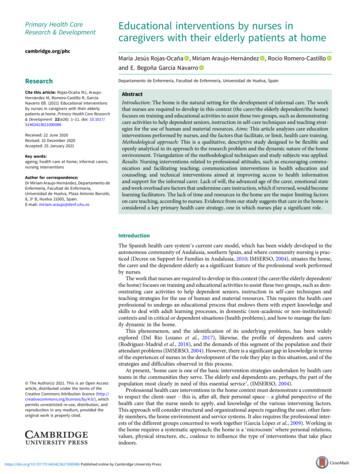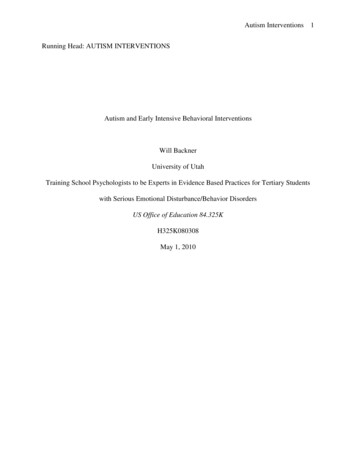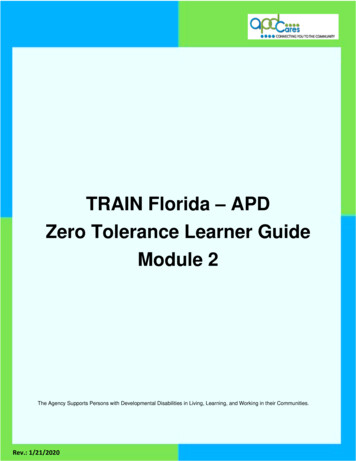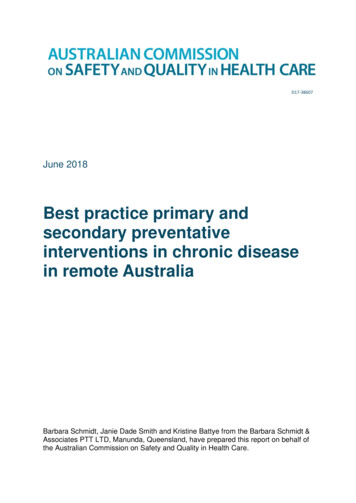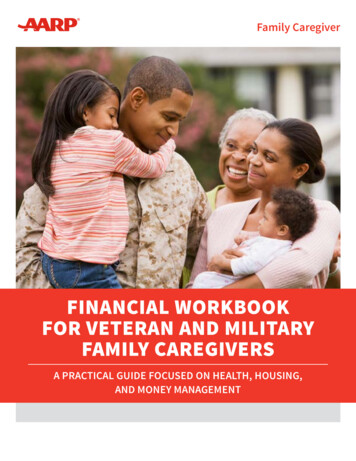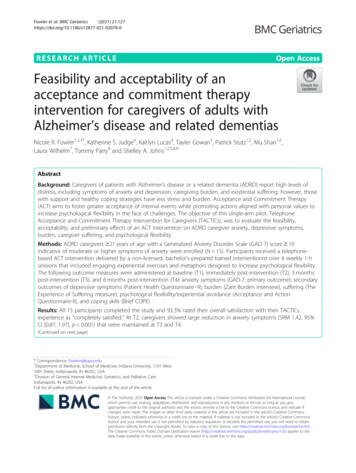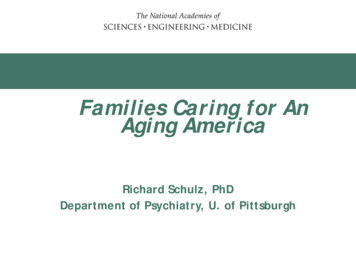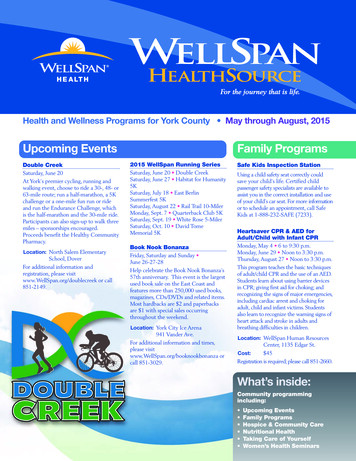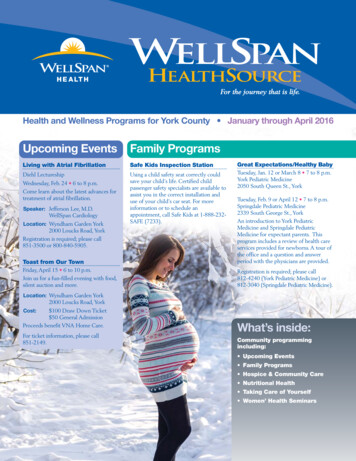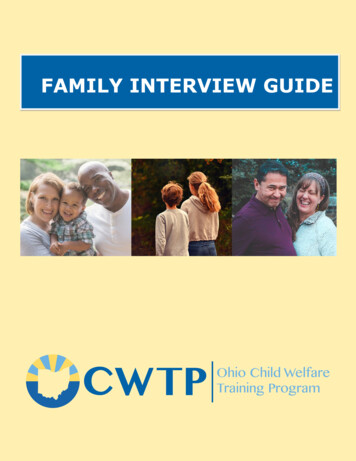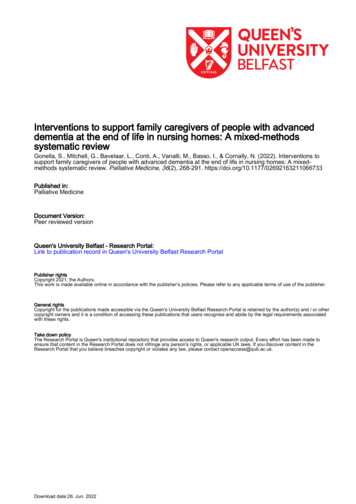
Transcription
Interventions to support family caregivers of people with advanceddementia at the end of life in nursing homes: A mixed-methodssystematic reviewGonella, S., Mitchell, G., Bavelaar, L., Conti, A., Vanalli, M., Basso, I., & Cornally, N. (2022). Interventions tosupport family caregivers of people with advanced dementia at the end of life in nursing homes: A mixedmethods systematic review. Palliative Medicine, 36(2), 268-291. https://doi.org/10.1177/02692163211066733Published in:Palliative MedicineDocument Version:Peer reviewed versionQueen's University Belfast - Research Portal:Link to publication record in Queen's University Belfast Research PortalPublisher rightsCopyright 2021, the Authors.This work is made available online in accordance with the publisher’s policies. Please refer to any applicable terms of use of the publisher.General rightsCopyright for the publications made accessible via the Queen's University Belfast Research Portal is retained by the author(s) and / or othercopyright owners and it is a condition of accessing these publications that users recognise and abide by the legal requirements associatedwith these rights.Take down policyThe Research Portal is Queen's institutional repository that provides access to Queen's research output. Every effort has been made toensure that content in the Research Portal does not infringe any person's rights, or applicable UK laws. If you discover content in theResearch Portal that you believe breaches copyright or violates any law, please contact openaccess@qub.ac.uk.Download date:26. Jun. 2022
Palliative MedicineTitleInterventions to support family caregivers of people with advanced dementia at the end of life innursing homes: a mixed-methods systematic reviewRunning headSupport advanced dementia family caregiversAuthorsSilvia Gonellaa,b, RN, MSc, PhD; Gary Mitchellc, RN, MSc, PhD; Laura Bavelaard, MSc, PhDs;Alessio Contia, RN, MSc, PhD; Mariangela Vanallie, RN, MSc, PhDs; Ines Bassof, RN, MSc; NicolaCornallyg RGN, MSc, PhDFoAuthors affiliationa DepartmentrPof Public Health and Pediatrics, University of Torino, via Santena 5 bis, 10126 Torino,Italy.b AziendaOspedaliero Universitaria Città della Salute e della Scienza di Torino, Corso Bramante 88-of Nursing & Midwifery, Queen’s University Belfast, Medical Biology Centre, 97 Lisburnd DepartmentevRoad, Belfast, BT97BL, Northern Ireland.of Public Health and Primary Care, Leiden University Medical Center, Hippocratespadiew21, 2300 RC Leiden, The NetherlandserR90, 10126 Torino, Italy.c 1525354555657585960Page 6 of 60Department of Biomedicine and Prevention, University of Roma Tor Vergata, Via Montpellier 1,00133 Roma, Italy.f Schoolof Nursing, Azienda Ospedaliera "SS Antonio e Biagio e Cesare Arrigo", Via Venezia 16,15121, Alessandria, Italy.g CatherineMcAuley School of Nursing and Midwifery, University College Cork, Brookfield HealthSciences Complex College Road Cork, T12 AK54, Cork, Ireland.Corresponding authorSilvia Gonella, RN, PhDDepartment of Public Health and Pediatrics, University of TorinoVia Santena 5 bis, 10126 Torino, ItalyAzienda Ospedaliero Universitario Città della Salute e della Scienza di TorinoCorso Bramante 88-90, 10126 Torino, liative-medicine
Page 7 of 60Phone 39 011 0915831Fax 39 011 2365831Email silvia.gonella@unito.itWord count : 4995AuhtorshipAuthors of Manuscript: AC, IB, GM, LB, MV, NC and SGGM, IB, and SG contributed to the conception and design of the work; IB, GM, LB, MV and SGextracted and analysed the data. All authors contributed to interpret data and draft the manuscript. Allauthors critically revised the manuscript, agree to be fully accountable for ensuring the integrity andFoaccuracy of the work, and read and approved the final 445464748495051525354555657585960Palliative palliative-medicine
Palliative MedicineAbstractBackground: Most people with dementia transition into nursing homes as their disease progresses.Their family caregivers often continue to be involved in their relative’s care and experience high levelof strain at the end of life.Aim: To gather and synthesize information on interventions to support family caregivers of peoplewith advanced dementia at the end of life in nursing homes and provide a set of recommendations forpractice.Design: Mixed-Methods Systematic Review (PROSPERO no. CRD42020217854) with convergentintegrated approach.Data Sources: Five electronic databases were searched from inception in November 2020. Publishedqualitative, quantitative and mixed-method studies of interventions to support family caregivers ofFopeople with advanced dementia at the end of life in nursing home were included. No language ortemporal limits were applied.rPResults: In all, 11 studies met the inclusion criteria. Data synthesis resulted in three integratedfindings: (i) healthcare professionals should engage family caregivers in ongoing dialogue andeeprovide adequate time and space for sensitive discussions; (ii) end-of-life discussions should be faceto-face and supported by written information whose timing of supply may vary according to familyrRcaregivers’ preferences and the organizational policies and cultural context; and (iii) familycaregivers should be provided structured psychoeducational programmes tailored to their specificevneeds and/or regular family meetings about dementia care at the end of life.Conclusion: The findings provide useful information on which interventions may benefit 51525354555657585960Page 8 of 60caregivers of people with advanced dementia at the end of life and where, when, and how they shouldbe provided.Keywords: Education, dementia, family, health communication, nursing homes, systematic review,palliative care, terminal liative-medicine
Page 9 of 60Key statementsWhat is already known about the topic? Several people with advancing dementia move permanently into nursing homes due toincreasing disability and dependence. Family caregivers of people with dementia experience the highest level of strain when theirrelative’s death is nearing and they often live in nursing homes. Family caregivers of people with dementia at the end of life have specific information andsupport needs related to the emotional impact of dementia and their decision-making role. Supporting family caregivers during the end-of-life stage prepares them emotionally for theirrelative’s death and helps them cope with their caregiving role.What this paper adds?This paper focuses on support for family caregivers of people with dementia at end of life inrP Fonursing homes while most literature addresses family caregivers of people living in thecommunity or during the transition to the nursing home. eeOngoing discussions between family caregivers and healthcare professionals facilitatespartnership, promotes informed and shared decisions, is a source of emotional support, andrRessential to family caregivers’ empowerment. Preferred timing of information provision about care options in advanced dementia is highlyevinfluenced by individual preferences and context. Psychoeducational programmes and regular meetings with trusted healthcare 748495051525354555657585960Palliative Medicinetailored to family caregivers’ specific and changing emotional and information needs canpromote self-care and empowerment. Interacting with peers and healthcare professionals independent from the nursing home orexperienced in psychological care may help family caregivers to identify their dementiaeducation needs, manage distress and develop problem-solving skills.Implications for practice, theory or policy Interventions to support family caregivers of people with advanced dementia at the end of lifeshould include timely and ongoing face-to-face discussions complemented by writteninformation and structured psychoeducational programmes which provide targeted socioemotional care in addition to tailored information, while involving a multiprofessional teamand possibly alliative-medicine
Palliative Medicine Goverments must acknowledge support of family caregivers of people with advanceddementia as a public health priority and invest resources in programs to provide themevidence-based support. Optimal support for family caregivers of people with advanced dementia at the end of life canpromote their empowerment resulting in improved self-care attitudes and greater engagementin shared decisions for their relative’s end-of-life care. Further research could assess how peer support and professional support for family caregiversof people with dementia in the nursing home may complement each 464748495051525354555657585960Page 10 of ative-medicine
Page 11 of 60IntroductionDementia is a cluster of terminal neurodegenerative disorders characterized by progressive andirreversible cognitive and functional decline, particularly among older adults.1 It is estimated thataround 50 million people currently have dementia worldwide, and there are nearly 10 million newcases every year.2 The total number of people with dementia is projected to reach 82 million in 2030and 152 in 2050.2, 3 Most people with dementia and their family caregivers desire that they remain athome for as long as possible4 and there is growing research about interventions which aim to postponetransition to nursing homes.5, 6 These facilities are also known as aged-care or long-term care homesand provide nursing care and assistance in activities of daily living in addition to room and board.7However, about 75% of people with dementia move permanently into nursing homes at some pointof the disease trajectory due to increasing disability and dependence.4, 8 This means that healthcareFoprofessionals working in nursing homes increasingly care for people living with dementia and theirfamily caregivers.9rPFamily caregivers of people with dementia are at increased risk of burden, stress, and depression.10,11Despite literature shows that some family caregivers experience less clinically significant burdeneeand depressive symptoms once their relative moves to a nursing home, particularly for those wholived with the person with advanced dementia in the community as their caregiving responsibilitiesrRdecrease,12 often the burden of caregiving persists after a relative moves to a nursing home13, 14 andlevels of strain increase near the end of life.15Indeed, most family caregivers continue to occupy aevpivotal position in the decision-making process as surrogate decision-maker after their relative’smove to the nursing home.16, 17 This suggests that entering a nursing home does not necessarily 51525354555657585960Palliative Medicinethe end of caregiving but rather identifies a new phase of the caregiving trajectory, which may be aschallenging as or even more than caregiving at home.18 Therefore, family caregivers of people withdementia need continuous support, from a relative’s move to a nursing home to realign their role19until death since high level of family caregivers’ anticipatory grief was suggested to be associatedwith worse well-being outcomes post-death.20, 21The World Health Organization recognizes support for family caregivers of people with advanceddementia as a public health priority.2 Particularly, family caregivers need both guidance in takingdecisions for their relative’s end-of-life care22 and social and emotional support.23Supporting family caregivers during the end-of-life stage may be particularly worthy not only withrespect to offering them resources to tackle their strain thus avoiding prolonged or complicatedgrief,20, 24 but also to help them cope with their caregiving role as a best interest decision-maker onbehalf of their relative who may lack capacity.23 Caring for family caregivers by providinginformation about the course of dementia and treatment options as well as attending to lliative-medicine
Palliative Medicineemotional, psychosocial, and spiritual needs should be planned for throughout the overall diseasetrajectory.23 However, literature mainly focuses on the support that family caregivers of people withdementia receive when they are still at home25 and during the transition towards the nursing home,26,27while knowledge about the support in taking challenging decisions about goals of care andtreatments during the final weeks or a few months of their relative’s life (hereafter end of life) is poorand fragmented. Therefore, this literature review aims to gather and synthesize information oninterventions to support family caregivers of people with advanced dementia at the end of theirrelative’s life in nursing homes and provide a set of recommendations for practice.The central question driving this research is: what interventions support family caregivers of peoplewith advanced dementia at end of life in nursing homes?MethodsrPDesignFoA systematic review according to the Joanna Briggs Institute methodology for Mixed-MethodsSystematic Review was performed.28eeThis review has been reported in accordance with the Synthesis Without Meta-analysis (SWiM)guidelines29 (Appendix 1) and Preferred Reporting Items for Systematic Reviews and Meta-AnalysesrR(PRISMA) guidelines30 (Figure 1) to enhance the quality and transparency of reporting. The reviewprotocol was registered on PROSPERO register of systematic reviews on 5 November athttps://www.crd.york.ac.uk/prospero/display record.php?ID 64748495051525354555657585960Page 12 of 60Search StrategyA three-step search strategy was employed: 1. an explorative search on PubMed and CINAHLEBSCO was conducted in October 2020 followed by an analysis of title, abstract and the index termsto identify the most appropriate keywords; 2. five databases (PubMed, CINAHL EBSCO, PsychInfoEBSCO, Joanna Briggs Institute, and Scopus) were searched from inception on November 5th 2020.Searches employed both controlled vocabularies and free terms, without temporal or language limits.Search strategies were adapted for each database (Appendix 2); 3. the references of included articleswere screened to identify further relevant publications.Inclusion and exclusion /palliative-medicine
Page 13 of 60PopulationStudies were included if they focused on any type of interventions aimed at supporting familycaregivers of people with advanced dementia at the end of life in nursing homes by promoting theirawareness and resilience. End of life was defined as the final weeks or a few months of a relative’slife.31Interventions delivered at the organizational level (e.g., care coordination program, respite program)or at the societal/policy level (e.g., payment rules, waiver programs, direct services to caregivers ofpeople with dementia, policies regarding unpaid or paid leave for caregivers) as well as residentoriented support interventions were excluded. Interventions at the organizational level were excludedsince they are usually delivered in community settings and aimed at relieving caregivingresponsibilities on a temporary or periodic basis during the disease trajectory, rather than promotingFofamily caregivers’ awareness and resilience, thus not providing an ongoing support for the end-oflife phase. Interventions at the societal/policy level were excluded since public support may widelyrPvary across jurisdictions, thus preventing from providing generalizable recommendations. Caregiveroriented support interventions as part of multi-faceted programmes were included only wheneecaregiver-oriented support interventions were clearly recognizable and assessable.Family caregivers of people with advanced dementia were defined as the relative, partner, closerRfriend, or neighbor who provides assistance in activities of daily living, or social or emotional supportto the person with dementia, or assumes an advocacy role.32iewPhenomena of 051525354555657585960Palliative MedicineThe review considered studies that investigated all forms of interventions delivered at the caregiverlevel (e.g., educational, psychosocial, and psychological interventions) which are employed tosupport family caregivers of people with advanced dementia at the end of life in nursing homes.ContextStudies merging caregiver-oriented support interventions across different settings (i.e. home, publichospital, hospice, private hospital and assisted living) were included only when the results related tothe nursing homes were clearly distinguishable. Nursing home was defined as a facility that providesroom and board, as well as management of chronic medical conditions and nursing care andinterventions with activities of daily living for patients who are physically and/or ptcentral.com/palliative-medicine
Palliative MedicineTypes of studiesQuantitative, qualitative and mixed methods studies were considered. Quantitative studies includedcross-sectional studies, pre-post studies, clinical trials, controlled clinical trials, and randomizedcontrolled trials; qualitative studies included qualitative descriptive, phenomenology, groundedtheory, ethnography, case study, and action research design. Mixed methods studies were consideredif data from the quantitative or qualitative components were clearly recognizable. When studies werequantitative according to the study authors but also reported qualitative data, the study was considered“quantitative” but both qualitative and quantitative data were included.Theses, dissertations, abstracts in proceedings and other papers published in non-peer-reviewedpublications (e.g. government working papers) as well as research protocols were excluded.Screening and study selectionrPFoAll identified articles were loaded into EndNote X9 (Clarivate Analytics, PA, USA) and duplicatesremoved. Titles, abstracts, and finally full texts, were screened by two independent reviewers foreeassessment against the inclusion and exclusion criteria.Assessment of methodological qualityrRThe selected papers were independently assessed by two reviewers for methodological validity usingevJoanna Briggs Institute critical appraisal tools for survey designs reporting frequencies/proportions,33randomized controlled trials,34 qualitative studies,35 and case reports.36 Details of the items 95051525354555657585960Page 14 of 60in each critical appraisal tool are reported in Appendix 3. No studies were excluded on the basis ofmethodological quality.Data extractionTwo independent reviewers extracted data including author(s), year, type of study (i.e., quantitative,qualitative, and mixed methods), methodology (e.g., cohort, phenomenology), geographical contextand other context-related information, number and characteristics of participants, phenomena ofinterest, data collection, data analysis, and main findings according to the Joanna Briggs Institutemixed methods data extraction form following a convergent integrated approach.28 Moreover, detailsregarding the interventions delivered to support family caregivers were extracted, when available.Quantitative data comprised of averages or percentages that profiled the sample as well as allrelationships between study variables and outcome. Qualitative data comprised of themes orsubthemes relevant to the review question with corresponding illustrations (i.e., participants’ alliative-medicine
Page 15 of 60quotations or the exact words of the authors), which were assigned a level of credibility based on thecongruency of the finding with supporting data: unequivocal (evidence beyond reasonable doubt);credible (plausible in light of the data and theoretical framework); or unsupported (no relationshipbetween findings and data).37 Only findings unequivocal and credible were included in the synthesis.Each finding was identified by an alphanumeric code (e.g. A1, A2, B1, ). Each letter correspondedto a study and each number to a unique finding. The progressive letters indicate the order of studyinclusion in the review, while the progressive numbers indicate the order of findings in the originalarticle (Table 1, Table 2, Table 3).Data transformationThe quantitative data was converted into ‘qualitized data’ because codifying quantitative data is lessFoerror-prone than attributing numerical values to qualitative data.28 Qualitized data comprised textualdescriptions or narrative interpretation of the quantitative results (e.g., ‘Undergoing some type ofrPeducational programme as a significant factor in predicting less role overload, less stress related tothe caregiving situation, more frequent use of reframing, and greater competence dealing witheehealthcare professionals’ is the transformation identified from a three-arm randomized study aimedat testing the efficacy of a psychoeducational programme compared to a comparison programme orrRno programme in enhancing mental health of women caregivers of a relative with dementia living ina long-term care setting that used prediction analysis).38iewData synthesis and 495051525354555657585960Palliative MedicineThe convergent integrated approach to synthesis according to the Joanna Briggs Institutemethodology for Mixed-Methods Systematic Review,28 based on previous work of Sandelowski39and Hong40 was adopted. Qualitized data were assembled with the qualitative data directly extractedfrom qualitative studies. Assembled data were categorized and pooled together based on similarity inmeaning (i.e., a category may integrate two or more types of data: qualitative data, qualitized data ora combination of both). Categories were aggregated to produce a set of integrated findings in the formof a set of recommendations or conclusions.Appraisal of level of evidenceThe level of evidence was assessed at the study level. The level of evidence for quantitative studieswas assessed using the Grading of Recommendations Assessment, Development and Evaluation(GRADE) system,41 that ranks evidence as very low, liative-medicine
Palliative Medicinemoderate, and high. According to this approach, all randomized controlled trials start with a rankingof ‘high’ while all other study designs start with ‘low’. This a-priori rank can then be adjusted (i.e.,downgraded or upgraded) after considering eight assessment criteria and making a judgement aboutquality based on these.The ConQual system was used to establish the confidence for qualitative evidence which includedqualitative studies and integrated findings.42 According to the ConQual approach, all qualitativestudies start with a ranking of ‘high’ on a scale of very low, low, moderate, and high. This rankingsystem then allows the findings of individual studies to be downgraded based on their dependability(i.e., appropriateness of the conduct of the research with research aims and purpose) and credibility(i.e., findings classified as unequivocal, credible, or unsupported).37 The integrated finding may thenbe downgraded based on the aggregate level of dependability from across the included findings.FoDowngrading for credibility may occur when not all the findings included in an integrated findingare considered unequivocal.42rPAny disagreements during the selection process, quality assessment, data extraction, transformation,synthesis and integration, and appraisal of the level of evidence was resolved by involving a thirdeereviewer.rRResultsReview processevOf the 1722 articles identified, after duplicate removal (n 298) and screening for title and abstract(n 1398), 26 entered the full text review process. Fifteen articles were further excluded 95051525354555657585960Page 16 of 60to the above-mentioned criteria; no articles were included from the reference lists of selected papers.Finally, eight quantitative studies and three qualitative studies were included in the review (Figure1).Quality assessment is reported in Table 1 and Appendix 3.Characteristics of included studiesThe included studies were conducted in seven countries: two in the United Kingdom,43, 44 two in theUnited States,45, 46 two in Canada,38, 47 one in Australia,48 one in the Netherlands,49 and three weretransnational studies.50-52All except two studies38, 47 on the same cohort of patients were conducted after 2010.Studies involved a median of twelve nursing homes, from one45,46to 4443; only two studiesreported the nursing home size which ranged from 40 to 99 beds.43, 44 Nursing homes had a main liative-medicine
Page 17 of 60profit43 or not for-profit38, 47, 50 profile. No information was provided about physician availability inthe facilities.The qualitative studies employed an ethnographic,44 qualitative descriptive,48 or longitudinal casestudy46 methodology. The quantitative studies adopted randomized controlled38,45, 47and cross-sectional43, 49-52 designs.Qualitative data were collected from face-to-face semi-structured individual interviews with familycaregivers (n 2)38, 44 and healthcare professionals (n 2),44, 48 healthcare professionals’ reflectivediary (n 1),44 and email letters (n 1).46 Quantitative data were collected from postal questionnaires(n 4),49-52 family caregivers’ structured face-to-face interviews with the questionnaire format (n 3),38, 47, 51 telephone questionnaires (n 1),45 and online surveys (n 1).43Sample sizes ranged from one46 to 18850, with the qualitative studies having smaller samples. AFototal of 443 healthcare professionals, 437 family caregivers, and 49 nursing home directors arerepresented in the review findings.rPStudies explored the views of family caregivers,38, 45-47, 51 healthcare professionals,50, 52 and nursinghome managers,43 with two studies48, 49 including both family caregivers and healthcare professionalseeand one study44 family caregivers, healthcare professionals and nursing home managers (Table 1).rRInterventions to support family caregivers in included studiesIn all, seven unique interventions across 11 studies were identified. A booklet about comfort care inevadvanced dementia49-52 and a psychoeducational programme38, 47 were evaluated in multiple studies.Interventions were gathered into three main categories including a) provision of information (n 8495051525354555657585960Palliative Medicineb) psychoeducational programmes (n 2);38, 47 and c) family meetings associated with writteninformation,48 psychosocial support,45 education,44 or all these three aspects simultaneously46 (Table2). Specifically, included studies explored practices adopted to inform family caregivers of peoplewith dementia about end of life;43 acceptability and usefulness of written information alone49-52 or inassociation with family meetings48 to improve end-of-life discussions about dementia care; benefitsof psychoeducational programmes for family caregivers’ psychological health and competence indealing with healthcare professionals;38,47and benefits of family meetings associated withpsychosocial support,45 educational programmes,44 or written information and education46 (Table 1).Data synthesisOf the 46 findings extracted, 23 were qualitative and 23 quantitative (Table 1, Table 3). All qualitativefindings were rated as unequivocal and thus included in the synthesis in addition to the com/palliative-medicine
Palliative Medicinedata. The level of credibility for each qualitative finding with participants’ direct quotations isreported in Table 1.Qualitative and qualitized data were assembled into seven categories, then combined in the followingthree integrated findings (Table 3, Figure 2):Integrated finding 1. End-of-life dialogue should be ongoing and provide adequate time andspace for sensitive discussion to establish a family caregivers-healthcare professionalspartnership, promote shared decision-making and improve the quality of family caregivers’remaining time with their relative while offering emotional supportTwelve qualitative findings from four studies38, 44, 46, 48 formed two categories which constitutedthe first integrated finding. This integrated finding revealed that end-of-life discussions should startFoas early as possible in the disease trajectory when the first cognitive problems arise and be ongoing:this provides family caregivers emotional support and enough time to process information, thusrPestablishing a partnership between family caregivers and healthcare professionals and promotingshared decisions about end-of-li
f School of Nursing, Azienda Ospedaliera "SS Antonio e Biagio e Cesare Arrigo", Via Venezia 16, 15121, Alessandria, Italy. g Catherine McAuley School of Nursing and Midwifery, University College Cork, Brookfield Health Sciences Complex College Road Cork, T12 AK54, Cork, Ireland. Corresponding author Silvia Gonella, RN, PhD
